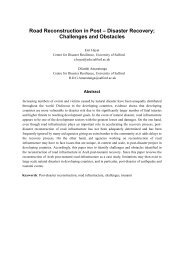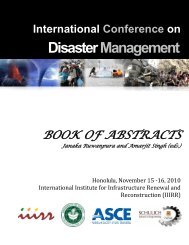Spatial Pattern of Socio-economic Landslide Vulnerability and its ...
Spatial Pattern of Socio-economic Landslide Vulnerability and its ...
Spatial Pattern of Socio-economic Landslide Vulnerability and its ...
You also want an ePaper? Increase the reach of your titles
YUMPU automatically turns print PDFs into web optimized ePapers that Google loves.
paddy field. Agricultural activity was dominant activity in the hilly area. Almost 60% <strong>of</strong> the<br />
respondents in the hilly area worked in agricultural sector.<br />
The second type <strong>of</strong> settlement pattern was clustered linear village settlement around road. It was<br />
usually characterized by engineered-semi engineered traditional brick with reinforced concrete<br />
column. Most <strong>of</strong> them were working in service sector <strong>and</strong> categorized as medium to high household<br />
income. They were mostly educated people <strong>and</strong> had more capability to cope with disaster. Besides<br />
<strong>of</strong> livestock as a saving system, they also saved their money in the bank. This social behavior was<br />
totally different with the people living in the hilly <strong>and</strong> remote area that had livestock only for their<br />
saving. This type <strong>of</strong> settlement pattern was concentrated in the western part <strong>and</strong> south-eastern part<br />
<strong>of</strong> Kayangan Catchment which were dominated by low topography. This place can be considered as<br />
a central <strong>economic</strong>, education, <strong>and</strong> local government activity. Those were also classified as low to<br />
medium socio-<strong>economic</strong> vulnerability level. Both spatial settlement patterns were illustrated in<br />
Figure 5.<br />
5. CONCLUSION<br />
<strong>Spatial</strong> pattern analysis had play important role to analyze socio-<strong>economic</strong> vulnerability in the rural area.<br />
Classified as a rural area, Kayangan Catchment is less experienced with agricultural modernization,<br />
industrialization <strong>and</strong> deindustrialization, <strong>and</strong> commodification <strong>of</strong> rural l<strong>and</strong>scapes. Thus, it reflects the<br />
societal character <strong>of</strong> rural behavior including social structure <strong>and</strong> culture. Since the nature <strong>of</strong> people, social<br />
structure <strong>and</strong> culture <strong>of</strong> Kayangan Catchment were less influenced by the development <strong>of</strong> technology <strong>and</strong><br />
modernization, the natural feature would more dominantly influence the socio-<strong>economic</strong> vulnerability in<br />
Kayangan Catchment. Determining environmental factors influencing socio-<strong>economic</strong> vulnerability was very<br />
helpful to predict spatial distribution <strong>of</strong> socio-<strong>economic</strong> vulnerability through fuzzy logic technique. Fuzzy<br />
membership function is generated by relating map classes <strong>of</strong> environmental variable to membership value.<br />
The fuzzy operator Or, Sum <strong>and</strong> high gamma value were successfully applied to predict spatial distribution<br />
<strong>of</strong> socio-<strong>economic</strong> vulnerability level. The result coincided with the <strong>economic</strong>, social <strong>and</strong> ecological<br />
dimensions <strong>of</strong> livelihood in Kayangan Catchment.<br />
REFERENCES<br />
(UNISDR) United Nations International Strategy for Disaster Reduction Secretariat. 2007. Hyogo Framework for Action 2005-2015:<br />
Building the Resilience <strong>of</strong> Nations <strong>and</strong> Communities to Disasters. United Nations International Strategy for Disaster<br />
Reduction Secretariat, Geneva.<br />
Birkmann, J. 2006. Measuring <strong>Vulnerability</strong> to Natural Hazards: towards Disaster Resilient Sicieties. United Nation University<br />
Press, Tokyo.<br />
BPS (Badan Pusat Statistik). 2008. Kulon Progo Regency in Figures 2008. BPS. Yogyakarta<br />
Costa, L <strong>and</strong> Kropp J, P. 2012. Linking components <strong>of</strong> <strong>Vulnerability</strong> in Theoretic Frameworks <strong>and</strong> Case Studies. Sustain Sci DOI<br />
10.1007/s11625-012-0158-4<br />
Ebert, A., Kerle, N., & Stein, A. 2009. Urban Social <strong>Vulnerability</strong> Assessment with Physical Proxies <strong>and</strong> <strong>Spatial</strong> Metrics derived<br />
from Air- <strong>and</strong> Spaceborne Imagery <strong>and</strong> GIS Data. Nat Hazards 48:275294.<br />
Fekete, A. 2011. <strong>Spatial</strong> Disaster <strong>Vulnerability</strong> <strong>and</strong> Risk Assessment: Challenges in Their Quality <strong>and</strong> Acceptance. Nat Hazards<br />
61:1161-1178<br />
Fekete, A., Damm, M., Birkmann, J. 2010. Scales as Challenge for <strong>Vulnerability</strong> Assessment. Nat Hazards 55 (3):729-747<br />
Fischer, M. M. 2002. <strong>Spatial</strong> Analysis in Geography. International Encyclopedia <strong>of</strong> the Social & Behavioral Sciences 14752-14758<br />
Kaynia, A. M., Papathoma-Kohle, M., Neuhauser, B., Ratzinger, K., Wenzel, H., Medina-Cetina, Z. 2008. Probabilistic Assessment<br />
<strong>of</strong> <strong>Vulnerability</strong> to <strong>L<strong>and</strong>slide</strong>: Application to the Village <strong>of</strong> Lichtenstein, Baden-Wurttemberg, Germany. Engineering<br />
Geology 101:33-48.<br />
Kuhlicke, C., Scolobig, A., Tapsell, S., Steinfuhrer, A., De Marchi, B. 2011. Contextualizing Social <strong>Vulnerability</strong>: Finding from case<br />
Studies Across Europe. Nat Hazards 58:789-810<br />
Menoni, S., Molinari, D., Parker, D., Ballio, F., Tapsell. 2012. Assessing Multifaceted <strong>Vulnerability</strong> <strong>and</strong> Resilience in order to<br />
Design risk-mitigation Strategies. Nat Hazards DOI 10.1007/s11069-010-9666-7<br />
Wolf, S. 2012. <strong>Vulnerability</strong> <strong>and</strong> Risk: Comparing Assessment Approaches. Nat Hazards 61: 1099-1113.<br />
10<br />
- 529 -
















